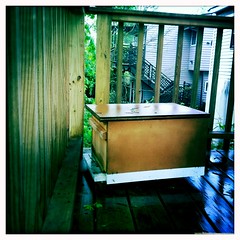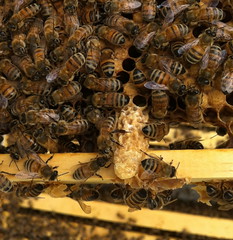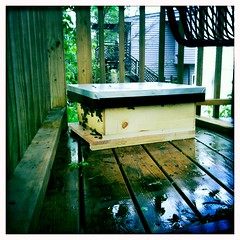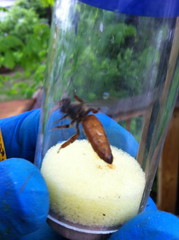 |
| our swarm catching box! |
There's a lot to talk about this time of year. But we'll restrain ourselves for now and get this post started with some pretty exciting news. We caught a swarm! And not just extracted one like Grant did last week--where he propped a ladder up to a tree and shook a bunch of bees from a branch into a box (not to downplay how much fun that was...) No, this one came to us.
But first, let's talk a minute about what a swarm is. It is the time of year where bees are wont to do this sort of thing, so as our neighbors, it is important that you understand it a bit. Swarming is a natural part of bees' life cycle: it's how they, as a colony, reproduce (it doesn't take long to realize that the real organism with honeybees is the colony, not the bee). And just like any living thing, bees are strongly motivated to do so. As a beekeeper, you want other hives to swarm (so you can harvest them) and you try your damnedest to prevent yours from doing so. That's a lot of bees to gain or lose.
 |
| capped queen cell |
So this is the process. The influx of pollen and nectar in the early spring flow gives the bees confidence that an offshoot colony could survive, so they go for it. The queen pushes into overdrive egg-laying and the workers, when the time is right, rear a new queen. Yup, the workers make a queen. First, they build 'queen cups,' or slightly larger cells that extend beyond the normal profile of the comb. When a queen lays an egg in this cup, the workers feed it royal jelly (which they make). All larva receive some royal jelly as they develop, but queens receive continuous and copious amounts of it through their entire larval and pupating life. It's what makes a queen a queen.
Several cells will get this treatment, as insurance. The eggs destined to be queens hatch, eat the royal jelly as larvae, pupate, get sealed into their cell by the workers, and eat more royal jelly. Despite the fact that the queen is a significantly larger bee, with a much longer lifespan, her adolescence lasts a significantly shorter time than either workers or drones (16ish days vs. 21ish days for workers and 24ish days for drones). This is most assuredly because when a queen is needed, she's NEEDED; she's the sole egg-layer for the entire colony. Yup, that royal jelly is really something.
 |
| subbed a proper medium hive body |
Once one or a few queen cells are capped, theoretically, the old queen will swarm with a sizable chunk of the bees in the colony, leaving the first pupating queen to emerge as the new matriarch (the first one will sting the remaining cells, killing them; if two emerge simultaneously, they duke it out). The old queen and the group of bees that leave with her...that's a swarm. They are looking for a new home. Because they don't have one yet, they have nothing to defend. Without a home, they are docile. This is important for folks to remember about swarms and the nature of bees. They don't want to sting you unless they really think you pose a threat to the colony. The act of stinging kills the bee, so it is therefore an act of hive defense, not self defense.
 |
| we marked the swarm's queen |
A swarm doesn't know where its new home will be when it leaves, so it will often camp out in a temporary location for a while (often in a tree). Scout bees will shoot off and scope out prospective homes. When one returns with a good location in mind, she'll signal the other bees via the waggle dance, and the swarm will move on it. It is in this staging area where they are most desirable and easiest to gather. This is the kind of swarm that Grant collected in the previous post from the upper boughs of a pine tree.
So, how does one catch a swarm without going through this 'harvesting' process? We set out a wooden box with frames and a little bit of lemongrass oil (the lemongrass oil is actually very similar to the scent produced by a bee's nasanov gland, which communicates a hive's location to other members of the colony). Basically, we wanted to just the sort of habitat a bee would look for. A scout bee from a swarm found our box and convinced the colony that she'd found the best new home.
So now we have a new hive. With local, survivor genetics from a proven queen. And what a queen she is. I think anyone can appreciate an abdomen like that!





No comments:
Post a Comment